Clinical Reasoning for Mild Traumatic Brain Injury Patient
VerifiedAdded on 2022/11/12
|8
|1810
|78
AI Summary
Read this clinical reasoning document for a patient suffering from mild traumatic brain injury. Learn about the cues, information, and processing of the patient's condition.
Contribute Materials
Your contribution can guide someone’s learning journey. Share your
documents today.
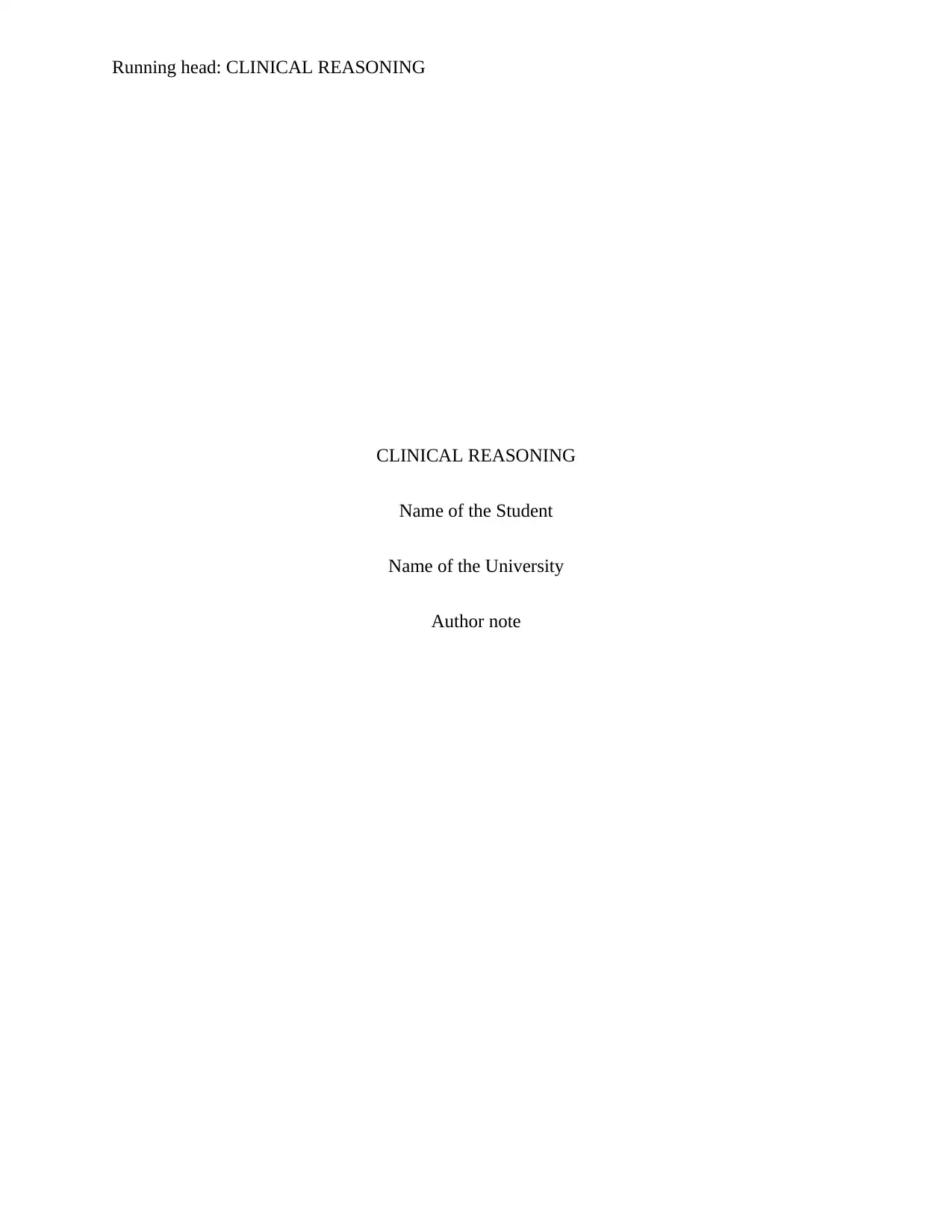
Running head: CLINICAL REASONING
CLINICAL REASONING
Name of the Student
Name of the University
Author note
CLINICAL REASONING
Name of the Student
Name of the University
Author note
Secure Best Marks with AI Grader
Need help grading? Try our AI Grader for instant feedback on your assignments.
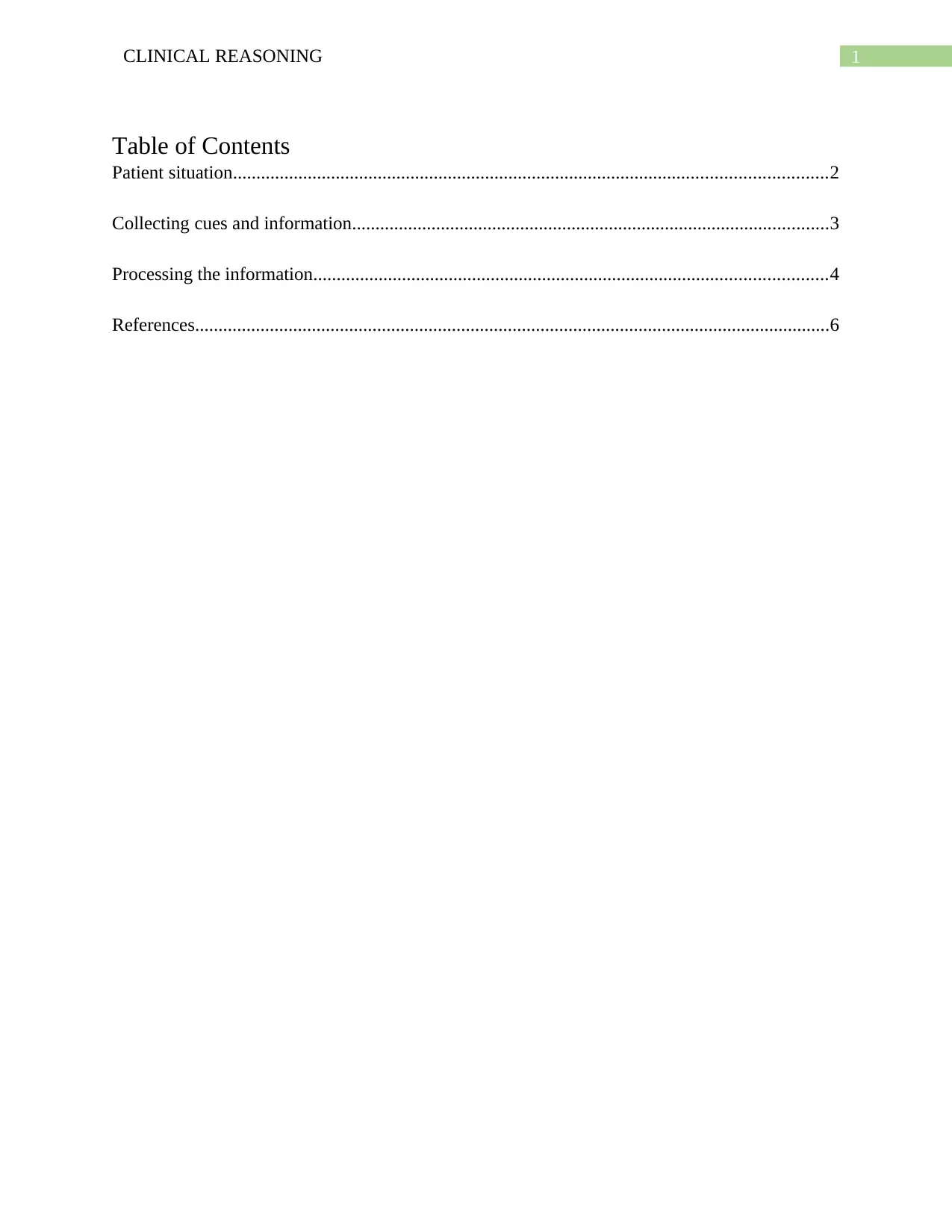
1CLINICAL REASONING
Table of Contents
Patient situation...............................................................................................................................2
Collecting cues and information......................................................................................................3
Processing the information..............................................................................................................4
References........................................................................................................................................6
Table of Contents
Patient situation...............................................................................................................................2
Collecting cues and information......................................................................................................3
Processing the information..............................................................................................................4
References........................................................................................................................................6
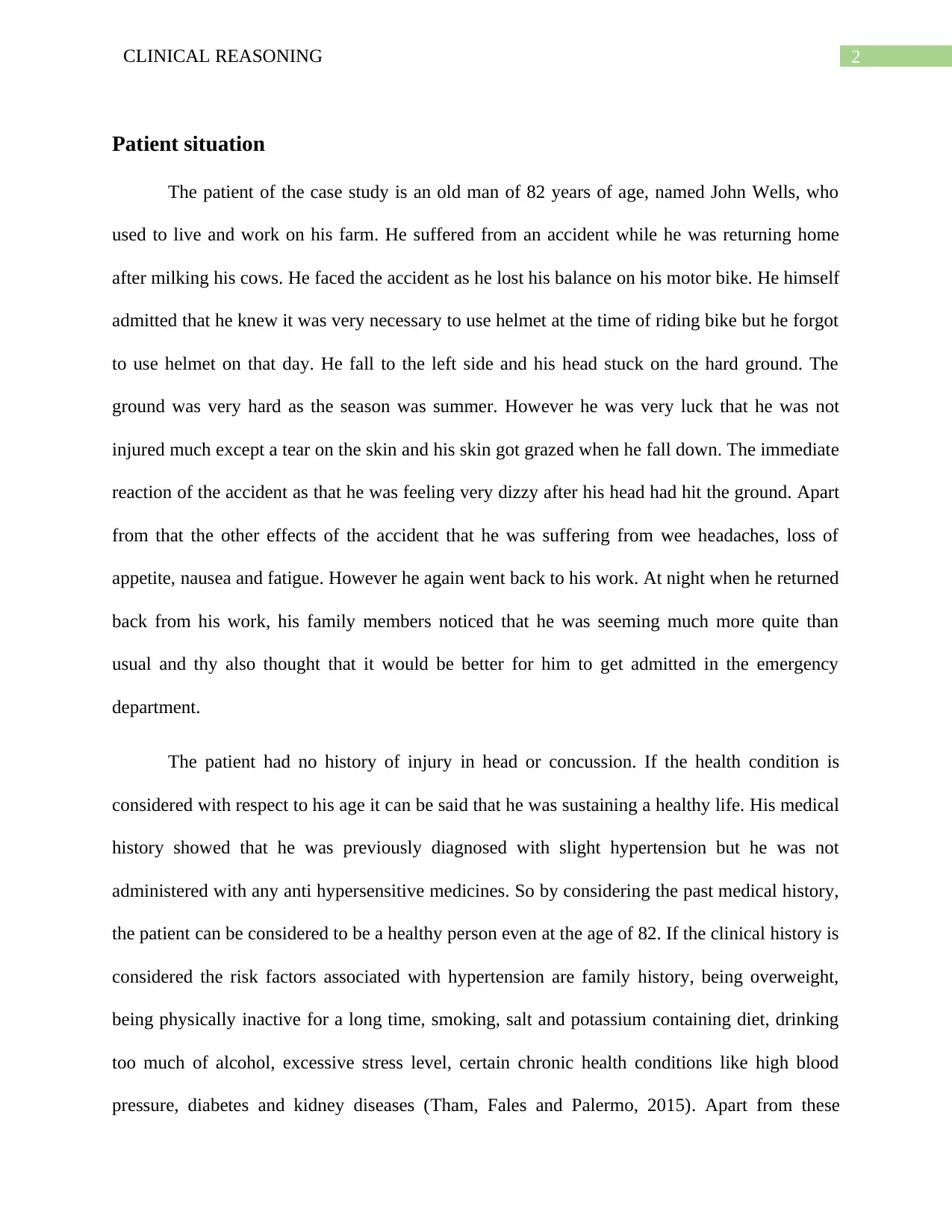
2CLINICAL REASONING
Patient situation
The patient of the case study is an old man of 82 years of age, named John Wells, who
used to live and work on his farm. He suffered from an accident while he was returning home
after milking his cows. He faced the accident as he lost his balance on his motor bike. He himself
admitted that he knew it was very necessary to use helmet at the time of riding bike but he forgot
to use helmet on that day. He fall to the left side and his head stuck on the hard ground. The
ground was very hard as the season was summer. However he was very luck that he was not
injured much except a tear on the skin and his skin got grazed when he fall down. The immediate
reaction of the accident as that he was feeling very dizzy after his head had hit the ground. Apart
from that the other effects of the accident that he was suffering from wee headaches, loss of
appetite, nausea and fatigue. However he again went back to his work. At night when he returned
back from his work, his family members noticed that he was seeming much more quite than
usual and thy also thought that it would be better for him to get admitted in the emergency
department.
The patient had no history of injury in head or concussion. If the health condition is
considered with respect to his age it can be said that he was sustaining a healthy life. His medical
history showed that he was previously diagnosed with slight hypertension but he was not
administered with any anti hypersensitive medicines. So by considering the past medical history,
the patient can be considered to be a healthy person even at the age of 82. If the clinical history is
considered the risk factors associated with hypertension are family history, being overweight,
being physically inactive for a long time, smoking, salt and potassium containing diet, drinking
too much of alcohol, excessive stress level, certain chronic health conditions like high blood
pressure, diabetes and kidney diseases (Tham, Fales and Palermo, 2015). Apart from these
Patient situation
The patient of the case study is an old man of 82 years of age, named John Wells, who
used to live and work on his farm. He suffered from an accident while he was returning home
after milking his cows. He faced the accident as he lost his balance on his motor bike. He himself
admitted that he knew it was very necessary to use helmet at the time of riding bike but he forgot
to use helmet on that day. He fall to the left side and his head stuck on the hard ground. The
ground was very hard as the season was summer. However he was very luck that he was not
injured much except a tear on the skin and his skin got grazed when he fall down. The immediate
reaction of the accident as that he was feeling very dizzy after his head had hit the ground. Apart
from that the other effects of the accident that he was suffering from wee headaches, loss of
appetite, nausea and fatigue. However he again went back to his work. At night when he returned
back from his work, his family members noticed that he was seeming much more quite than
usual and thy also thought that it would be better for him to get admitted in the emergency
department.
The patient had no history of injury in head or concussion. If the health condition is
considered with respect to his age it can be said that he was sustaining a healthy life. His medical
history showed that he was previously diagnosed with slight hypertension but he was not
administered with any anti hypersensitive medicines. So by considering the past medical history,
the patient can be considered to be a healthy person even at the age of 82. If the clinical history is
considered the risk factors associated with hypertension are family history, being overweight,
being physically inactive for a long time, smoking, salt and potassium containing diet, drinking
too much of alcohol, excessive stress level, certain chronic health conditions like high blood
pressure, diabetes and kidney diseases (Tham, Fales and Palermo, 2015). Apart from these
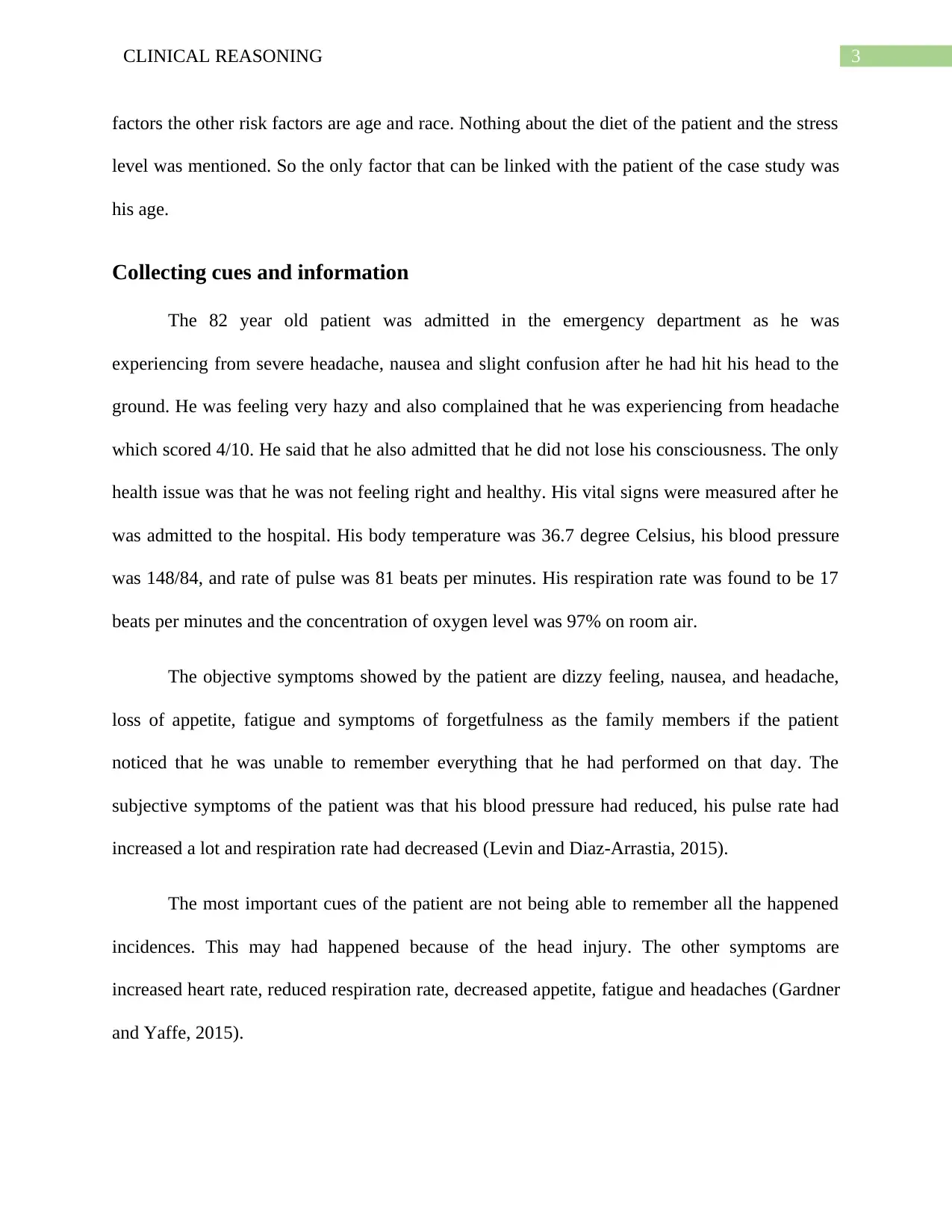
3CLINICAL REASONING
factors the other risk factors are age and race. Nothing about the diet of the patient and the stress
level was mentioned. So the only factor that can be linked with the patient of the case study was
his age.
Collecting cues and information
The 82 year old patient was admitted in the emergency department as he was
experiencing from severe headache, nausea and slight confusion after he had hit his head to the
ground. He was feeling very hazy and also complained that he was experiencing from headache
which scored 4/10. He said that he also admitted that he did not lose his consciousness. The only
health issue was that he was not feeling right and healthy. His vital signs were measured after he
was admitted to the hospital. His body temperature was 36.7 degree Celsius, his blood pressure
was 148/84, and rate of pulse was 81 beats per minutes. His respiration rate was found to be 17
beats per minutes and the concentration of oxygen level was 97% on room air.
The objective symptoms showed by the patient are dizzy feeling, nausea, and headache,
loss of appetite, fatigue and symptoms of forgetfulness as the family members if the patient
noticed that he was unable to remember everything that he had performed on that day. The
subjective symptoms of the patient was that his blood pressure had reduced, his pulse rate had
increased a lot and respiration rate had decreased (Levin and Diaz-Arrastia, 2015).
The most important cues of the patient are not being able to remember all the happened
incidences. This may had happened because of the head injury. The other symptoms are
increased heart rate, reduced respiration rate, decreased appetite, fatigue and headaches (Gardner
and Yaffe, 2015).
factors the other risk factors are age and race. Nothing about the diet of the patient and the stress
level was mentioned. So the only factor that can be linked with the patient of the case study was
his age.
Collecting cues and information
The 82 year old patient was admitted in the emergency department as he was
experiencing from severe headache, nausea and slight confusion after he had hit his head to the
ground. He was feeling very hazy and also complained that he was experiencing from headache
which scored 4/10. He said that he also admitted that he did not lose his consciousness. The only
health issue was that he was not feeling right and healthy. His vital signs were measured after he
was admitted to the hospital. His body temperature was 36.7 degree Celsius, his blood pressure
was 148/84, and rate of pulse was 81 beats per minutes. His respiration rate was found to be 17
beats per minutes and the concentration of oxygen level was 97% on room air.
The objective symptoms showed by the patient are dizzy feeling, nausea, and headache,
loss of appetite, fatigue and symptoms of forgetfulness as the family members if the patient
noticed that he was unable to remember everything that he had performed on that day. The
subjective symptoms of the patient was that his blood pressure had reduced, his pulse rate had
increased a lot and respiration rate had decreased (Levin and Diaz-Arrastia, 2015).
The most important cues of the patient are not being able to remember all the happened
incidences. This may had happened because of the head injury. The other symptoms are
increased heart rate, reduced respiration rate, decreased appetite, fatigue and headaches (Gardner
and Yaffe, 2015).
Secure Best Marks with AI Grader
Need help grading? Try our AI Grader for instant feedback on your assignments.
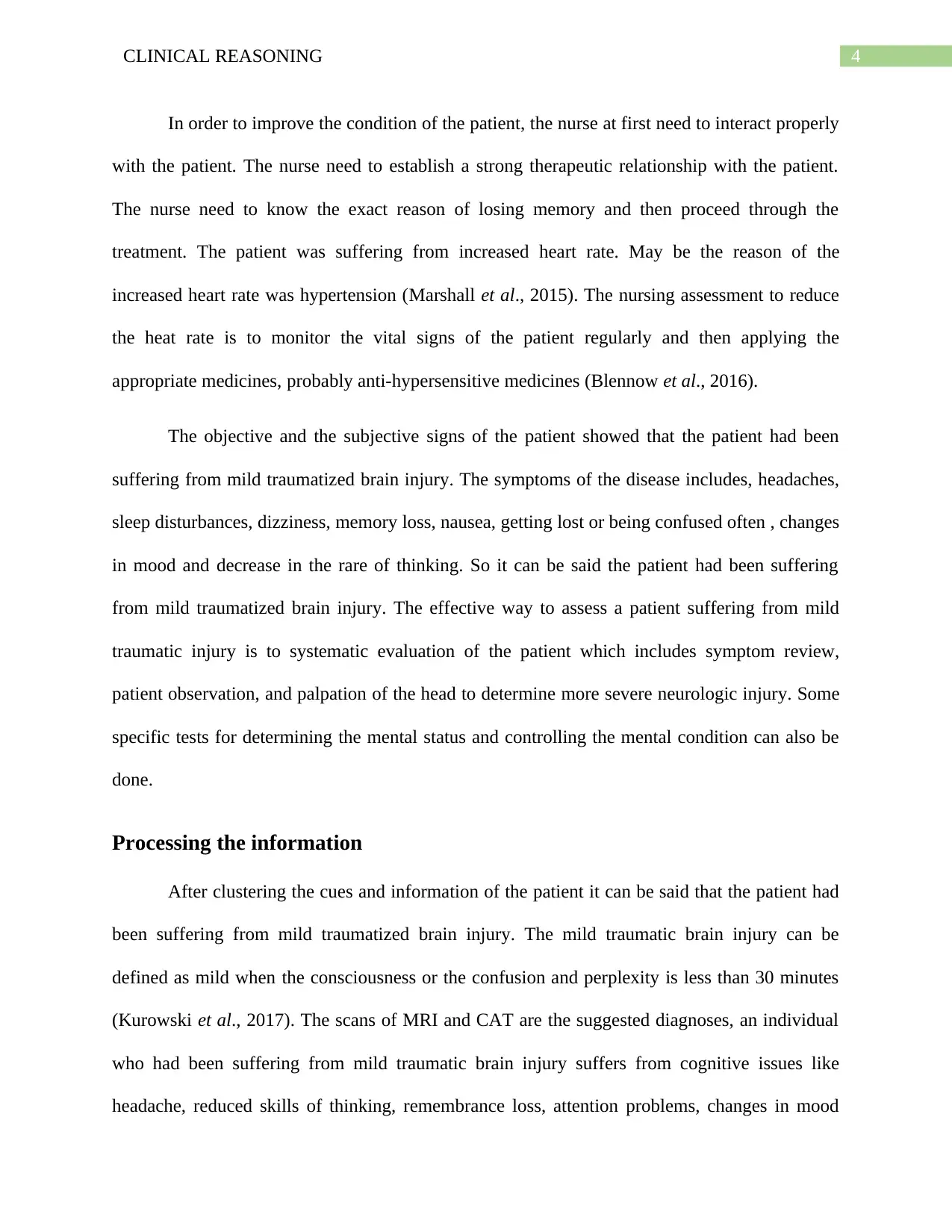
4CLINICAL REASONING
In order to improve the condition of the patient, the nurse at first need to interact properly
with the patient. The nurse need to establish a strong therapeutic relationship with the patient.
The nurse need to know the exact reason of losing memory and then proceed through the
treatment. The patient was suffering from increased heart rate. May be the reason of the
increased heart rate was hypertension (Marshall et al., 2015). The nursing assessment to reduce
the heat rate is to monitor the vital signs of the patient regularly and then applying the
appropriate medicines, probably anti-hypersensitive medicines (Blennow et al., 2016).
The objective and the subjective signs of the patient showed that the patient had been
suffering from mild traumatized brain injury. The symptoms of the disease includes, headaches,
sleep disturbances, dizziness, memory loss, nausea, getting lost or being confused often , changes
in mood and decrease in the rare of thinking. So it can be said the patient had been suffering
from mild traumatized brain injury. The effective way to assess a patient suffering from mild
traumatic injury is to systematic evaluation of the patient which includes symptom review,
patient observation, and palpation of the head to determine more severe neurologic injury. Some
specific tests for determining the mental status and controlling the mental condition can also be
done.
Processing the information
After clustering the cues and information of the patient it can be said that the patient had
been suffering from mild traumatized brain injury. The mild traumatic brain injury can be
defined as mild when the consciousness or the confusion and perplexity is less than 30 minutes
(Kurowski et al., 2017). The scans of MRI and CAT are the suggested diagnoses, an individual
who had been suffering from mild traumatic brain injury suffers from cognitive issues like
headache, reduced skills of thinking, remembrance loss, attention problems, changes in mood
In order to improve the condition of the patient, the nurse at first need to interact properly
with the patient. The nurse need to establish a strong therapeutic relationship with the patient.
The nurse need to know the exact reason of losing memory and then proceed through the
treatment. The patient was suffering from increased heart rate. May be the reason of the
increased heart rate was hypertension (Marshall et al., 2015). The nursing assessment to reduce
the heat rate is to monitor the vital signs of the patient regularly and then applying the
appropriate medicines, probably anti-hypersensitive medicines (Blennow et al., 2016).
The objective and the subjective signs of the patient showed that the patient had been
suffering from mild traumatized brain injury. The symptoms of the disease includes, headaches,
sleep disturbances, dizziness, memory loss, nausea, getting lost or being confused often , changes
in mood and decrease in the rare of thinking. So it can be said the patient had been suffering
from mild traumatized brain injury. The effective way to assess a patient suffering from mild
traumatic injury is to systematic evaluation of the patient which includes symptom review,
patient observation, and palpation of the head to determine more severe neurologic injury. Some
specific tests for determining the mental status and controlling the mental condition can also be
done.
Processing the information
After clustering the cues and information of the patient it can be said that the patient had
been suffering from mild traumatized brain injury. The mild traumatic brain injury can be
defined as mild when the consciousness or the confusion and perplexity is less than 30 minutes
(Kurowski et al., 2017). The scans of MRI and CAT are the suggested diagnoses, an individual
who had been suffering from mild traumatic brain injury suffers from cognitive issues like
headache, reduced skills of thinking, remembrance loss, attention problems, changes in mood
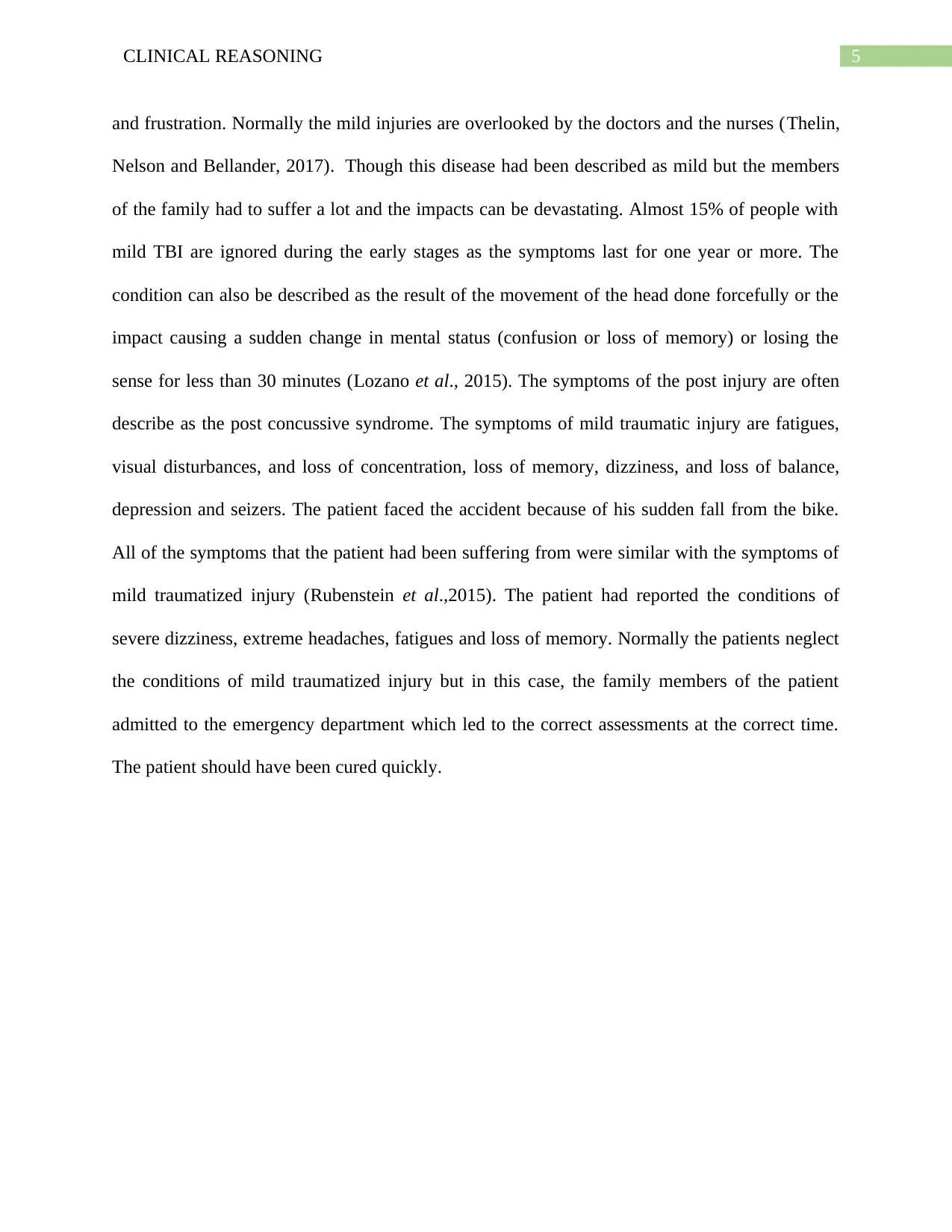
5CLINICAL REASONING
and frustration. Normally the mild injuries are overlooked by the doctors and the nurses (Thelin,
Nelson and Bellander, 2017). Though this disease had been described as mild but the members
of the family had to suffer a lot and the impacts can be devastating. Almost 15% of people with
mild TBI are ignored during the early stages as the symptoms last for one year or more. The
condition can also be described as the result of the movement of the head done forcefully or the
impact causing a sudden change in mental status (confusion or loss of memory) or losing the
sense for less than 30 minutes (Lozano et al., 2015). The symptoms of the post injury are often
describe as the post concussive syndrome. The symptoms of mild traumatic injury are fatigues,
visual disturbances, and loss of concentration, loss of memory, dizziness, and loss of balance,
depression and seizers. The patient faced the accident because of his sudden fall from the bike.
All of the symptoms that the patient had been suffering from were similar with the symptoms of
mild traumatized injury (Rubenstein et al.,2015). The patient had reported the conditions of
severe dizziness, extreme headaches, fatigues and loss of memory. Normally the patients neglect
the conditions of mild traumatized injury but in this case, the family members of the patient
admitted to the emergency department which led to the correct assessments at the correct time.
The patient should have been cured quickly.
and frustration. Normally the mild injuries are overlooked by the doctors and the nurses (Thelin,
Nelson and Bellander, 2017). Though this disease had been described as mild but the members
of the family had to suffer a lot and the impacts can be devastating. Almost 15% of people with
mild TBI are ignored during the early stages as the symptoms last for one year or more. The
condition can also be described as the result of the movement of the head done forcefully or the
impact causing a sudden change in mental status (confusion or loss of memory) or losing the
sense for less than 30 minutes (Lozano et al., 2015). The symptoms of the post injury are often
describe as the post concussive syndrome. The symptoms of mild traumatic injury are fatigues,
visual disturbances, and loss of concentration, loss of memory, dizziness, and loss of balance,
depression and seizers. The patient faced the accident because of his sudden fall from the bike.
All of the symptoms that the patient had been suffering from were similar with the symptoms of
mild traumatized injury (Rubenstein et al.,2015). The patient had reported the conditions of
severe dizziness, extreme headaches, fatigues and loss of memory. Normally the patients neglect
the conditions of mild traumatized injury but in this case, the family members of the patient
admitted to the emergency department which led to the correct assessments at the correct time.
The patient should have been cured quickly.
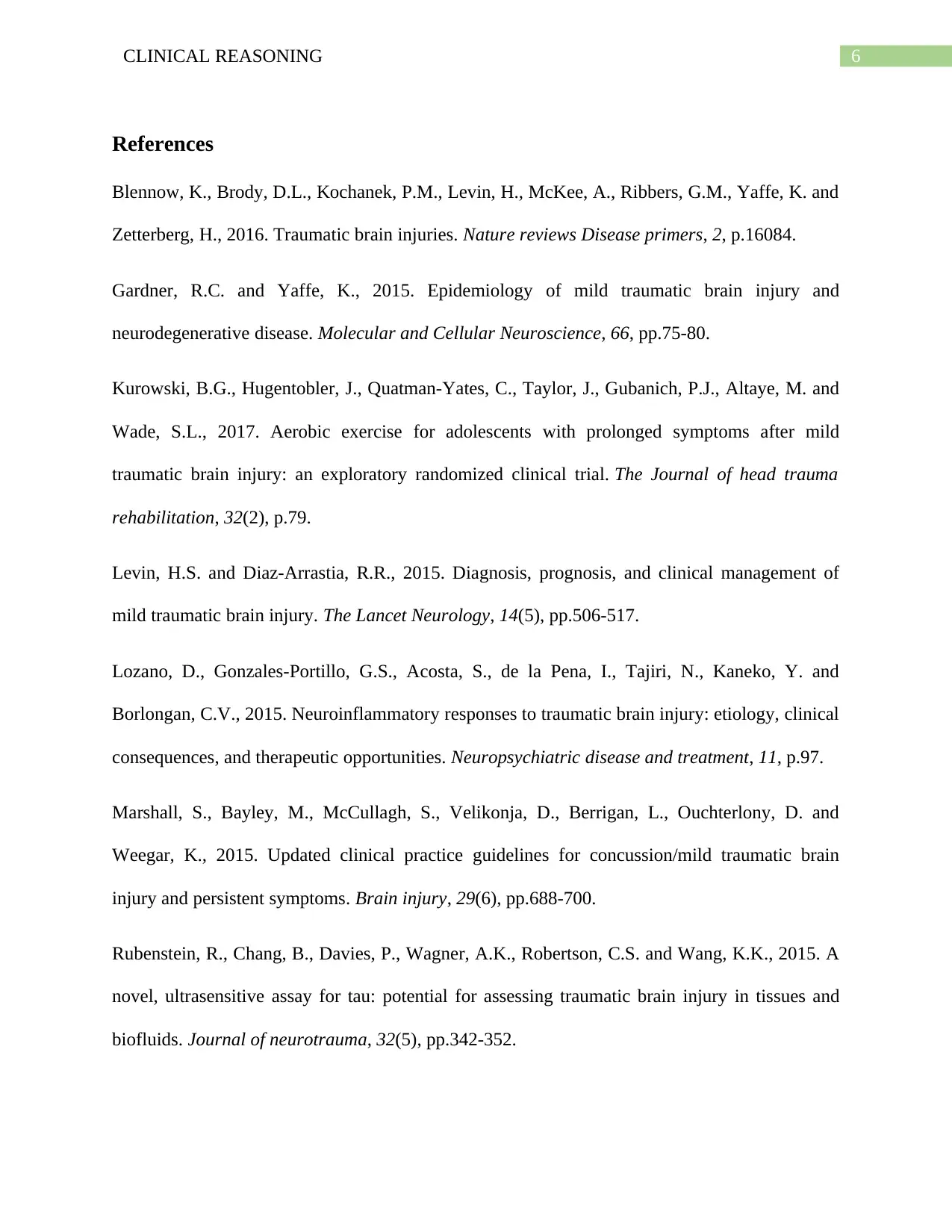
6CLINICAL REASONING
References
Blennow, K., Brody, D.L., Kochanek, P.M., Levin, H., McKee, A., Ribbers, G.M., Yaffe, K. and
Zetterberg, H., 2016. Traumatic brain injuries. Nature reviews Disease primers, 2, p.16084.
Gardner, R.C. and Yaffe, K., 2015. Epidemiology of mild traumatic brain injury and
neurodegenerative disease. Molecular and Cellular Neuroscience, 66, pp.75-80.
Kurowski, B.G., Hugentobler, J., Quatman-Yates, C., Taylor, J., Gubanich, P.J., Altaye, M. and
Wade, S.L., 2017. Aerobic exercise for adolescents with prolonged symptoms after mild
traumatic brain injury: an exploratory randomized clinical trial. The Journal of head trauma
rehabilitation, 32(2), p.79.
Levin, H.S. and Diaz-Arrastia, R.R., 2015. Diagnosis, prognosis, and clinical management of
mild traumatic brain injury. The Lancet Neurology, 14(5), pp.506-517.
Lozano, D., Gonzales-Portillo, G.S., Acosta, S., de la Pena, I., Tajiri, N., Kaneko, Y. and
Borlongan, C.V., 2015. Neuroinflammatory responses to traumatic brain injury: etiology, clinical
consequences, and therapeutic opportunities. Neuropsychiatric disease and treatment, 11, p.97.
Marshall, S., Bayley, M., McCullagh, S., Velikonja, D., Berrigan, L., Ouchterlony, D. and
Weegar, K., 2015. Updated clinical practice guidelines for concussion/mild traumatic brain
injury and persistent symptoms. Brain injury, 29(6), pp.688-700.
Rubenstein, R., Chang, B., Davies, P., Wagner, A.K., Robertson, C.S. and Wang, K.K., 2015. A
novel, ultrasensitive assay for tau: potential for assessing traumatic brain injury in tissues and
biofluids. Journal of neurotrauma, 32(5), pp.342-352.
References
Blennow, K., Brody, D.L., Kochanek, P.M., Levin, H., McKee, A., Ribbers, G.M., Yaffe, K. and
Zetterberg, H., 2016. Traumatic brain injuries. Nature reviews Disease primers, 2, p.16084.
Gardner, R.C. and Yaffe, K., 2015. Epidemiology of mild traumatic brain injury and
neurodegenerative disease. Molecular and Cellular Neuroscience, 66, pp.75-80.
Kurowski, B.G., Hugentobler, J., Quatman-Yates, C., Taylor, J., Gubanich, P.J., Altaye, M. and
Wade, S.L., 2017. Aerobic exercise for adolescents with prolonged symptoms after mild
traumatic brain injury: an exploratory randomized clinical trial. The Journal of head trauma
rehabilitation, 32(2), p.79.
Levin, H.S. and Diaz-Arrastia, R.R., 2015. Diagnosis, prognosis, and clinical management of
mild traumatic brain injury. The Lancet Neurology, 14(5), pp.506-517.
Lozano, D., Gonzales-Portillo, G.S., Acosta, S., de la Pena, I., Tajiri, N., Kaneko, Y. and
Borlongan, C.V., 2015. Neuroinflammatory responses to traumatic brain injury: etiology, clinical
consequences, and therapeutic opportunities. Neuropsychiatric disease and treatment, 11, p.97.
Marshall, S., Bayley, M., McCullagh, S., Velikonja, D., Berrigan, L., Ouchterlony, D. and
Weegar, K., 2015. Updated clinical practice guidelines for concussion/mild traumatic brain
injury and persistent symptoms. Brain injury, 29(6), pp.688-700.
Rubenstein, R., Chang, B., Davies, P., Wagner, A.K., Robertson, C.S. and Wang, K.K., 2015. A
novel, ultrasensitive assay for tau: potential for assessing traumatic brain injury in tissues and
biofluids. Journal of neurotrauma, 32(5), pp.342-352.
Paraphrase This Document
Need a fresh take? Get an instant paraphrase of this document with our AI Paraphraser
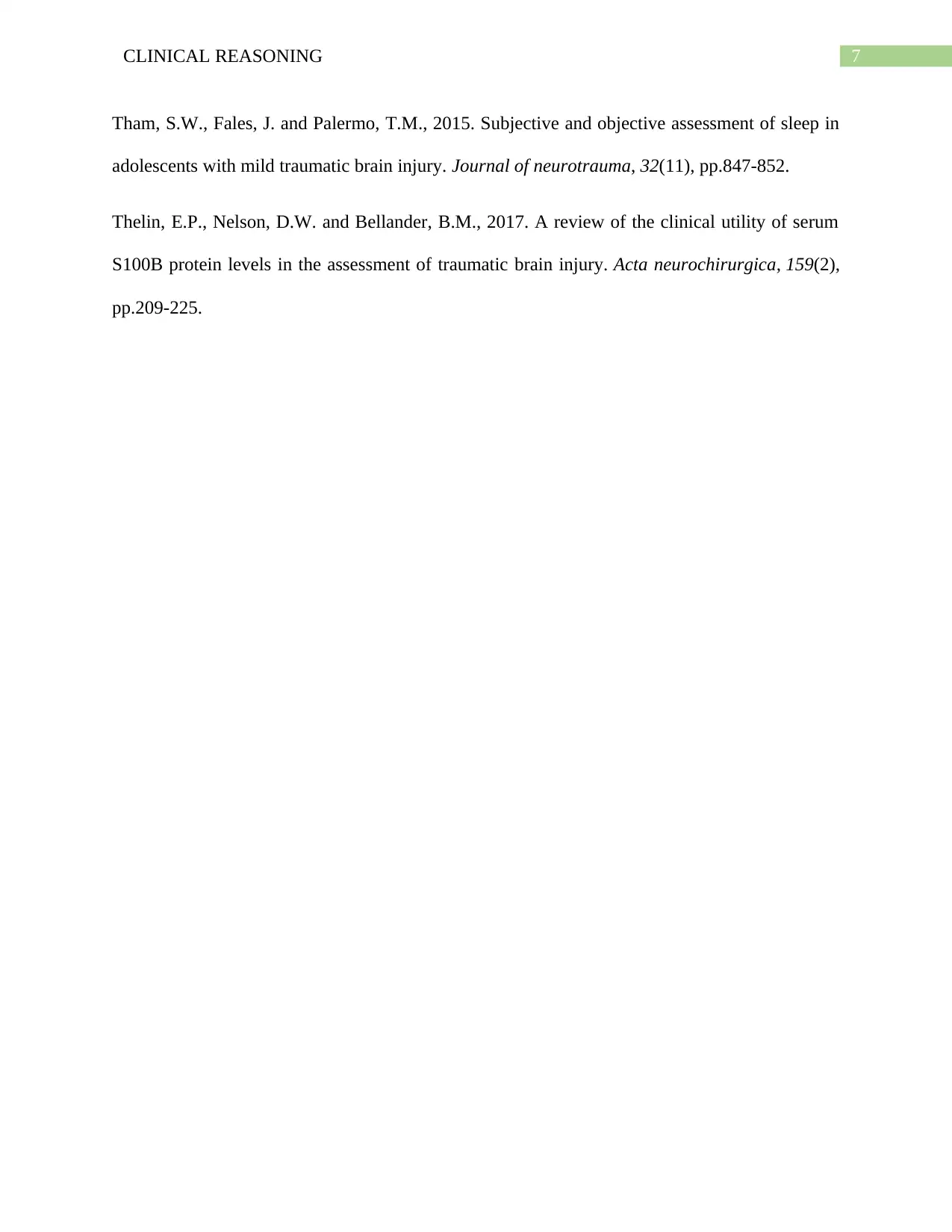
7CLINICAL REASONING
Tham, S.W., Fales, J. and Palermo, T.M., 2015. Subjective and objective assessment of sleep in
adolescents with mild traumatic brain injury. Journal of neurotrauma, 32(11), pp.847-852.
Thelin, E.P., Nelson, D.W. and Bellander, B.M., 2017. A review of the clinical utility of serum
S100B protein levels in the assessment of traumatic brain injury. Acta neurochirurgica, 159(2),
pp.209-225.
Tham, S.W., Fales, J. and Palermo, T.M., 2015. Subjective and objective assessment of sleep in
adolescents with mild traumatic brain injury. Journal of neurotrauma, 32(11), pp.847-852.
Thelin, E.P., Nelson, D.W. and Bellander, B.M., 2017. A review of the clinical utility of serum
S100B protein levels in the assessment of traumatic brain injury. Acta neurochirurgica, 159(2),
pp.209-225.
1 out of 8
Related Documents
Your All-in-One AI-Powered Toolkit for Academic Success.
+13062052269
info@desklib.com
Available 24*7 on WhatsApp / Email
![[object Object]](/_next/static/media/star-bottom.7253800d.svg)
Unlock your academic potential
© 2024 | Zucol Services PVT LTD | All rights reserved.





